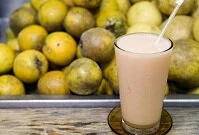Staple Foods
Plantains: often a side dish or an ingredient in the main course
Rice: a common base to meals or simply a side dish
Seafood: perhaps not a staple in the true sense, but found in many dishes
Regional Variations, Specialties, & Unique Dishes
Chen Chen: cornmeal pudding
La Bandera: meaning "the flag," this dish consists of rice, red beans, and stewed meat
Salchichon: salami, often served with fried green plantains
Sancocho: meat, vegetable, and plantain stew, sometimes also yucca, potatoes, or yams are included
Dining Etiquette
The Dominican Republic is in the Caribbean and the Caribbean is known for its relaxed and laid back atmosphere. However, when it comes to dining, especially in a local's home the rules are a bit more formal, although they people are quite forgiving of any mistakes you make.
If meeting locals for a meal, in either a restaurant or, especially, in a home, dress well as the people take pride in this and may judge you on your dress as well. However, arriving on time is not expected and 15 minutes late is generally considered on time, if not a bit early. Dressing well is the most formal part of the evening as dining is meant for conversation and the atmosphere, no matter the dress, will remain informal and relaxed.
Let your host show you your seat; if you are with a friend or significant other, expect that the two of you will be separated to stimulate greater conversation and to meet new people. Dining will probably begin with a toast and the word "salud" or an invitation to eat, "buen provecho."
Once the food is served, and in homes it is generally served family style, help yourself once the host invites you to do so; generally they will invite the guest to help themselves first. The Dominicans don't care much whether you eat in the continental style (knife in the right hand, fork in the left) as they do or the American style, but always keep your hands within sight by resting your wrists on the edge of the table.
As you finish eating, you are encouraged to leave just a bit of food on your plate to indicate you have been given more than enough food. Also, place your fork (prongs down) and knife together facing to the right of your plate to indicate you have finished.
If dining in a restaurant, call the server over to your table by making eye contact; don't wave or call his/her name. The inviter is expected to pay for everyone present, but all guests should make an effort to pay. If no tip is included in the bill (it usually isn't) then tip about 10% for good service.
Celebrations & Events
Many religious holidays in Dominican Republic, including Christmas and Easter, are celebrated with family and serve traditional meals. Christmas usually offers a full roasted pig along with beans as the main course, but numerous side dishes and desserts are also served to celebrate the holiday. Easter also contains numerous dishes, but the main course tends to be fish. Both holidays are centered around family and rarely will a visitor to the Dominican Republic experience these events in person.
A better time to try festival foods and drinks is during Carnival, which takes place just prior to Lent. This celebration, which is best experienced in La Vega, consists of music, dancing, eating, and drinking. It's a great time to try fattening local foods and you can also join the locals for a late night of drinking the local alcoholic beverages.
Another good time to try the local foods is on February 27 for Independence Day, or really any weekend during February. This is a time when the Dominican Republic shows what makes it unique through music, art, and food as some of the most authentic dishes are served during this time.
Finally, a growing festival is the El Festival del Merengue de Santo Domingo, which takes place in the capital in late July. Like Carnival, this is more of a music and dancing festival, but food and drinks are becoming more and more important aspects to the festival as you can try numerous local dishes.
Drinks

Melon juice
The Dominican Republic offers all the world's most popular drinks including tea, coffee, milk, juices, and soft drinks, but they also have a large number of unique drinks. Mabi (spelled "mauby" in some countries) is made from the bark of a tree then sweetened, boiled, and strained. The people also drink a pear, pineapple, and rice concoction called pera pina while orange, milk, and sugar is mixed to form morir sonando. There are many more local favorites worth trying as well so ask your hotel or restaurant for what's available, which may include oatmeal juice (jugo de avena) or peanut hot chocolate (chocolate de mani).
As far as alcoholic beverages are concerned the local drinks are not as unique. Beer is regularly consumed, including the local favorite, "Presidente," while rum is the most common hard liquor, which is best tried in a drink called mamajuana. Mamajuana is rum poured into a bottle with local sticks and tree roots and each person tends to make it a little differently. If you aren't feeling too adventurous international beers, wines, and other hard liquors are available.
The tap water in the Dominican Republic should not be consumed. Be sure to also avoid anything with ice as it may have been made from the tap water. Salads and fruits could have also been washed in the tap water so be careful with those foods as well.